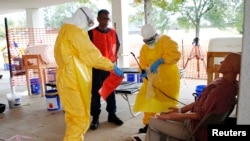Dr. Kwan Kew Lai's family and colleagues in Boston fear for the safety of the infectious disease physician when she travels to Liberia later this month to treat Ebola patients.
"I just feel like it's wrong for me to sit at home while I hear the news of people dying," said Lai, 63.
Dressed in a yellow full-body suit, Lai joined 35 other licensed health workers this week for new, hands-on safety training.
Developed by the U.S. Centers for Disease Control and Prevention as part of its escalated response to the worst Ebola outbreak on record, the three-day program teaches how to safely treat patients in West Africa with the virus, which causes fever and bleeding and is often fatal.
There is an urgent need for doctors, nurses and health care workers to volunteer in the hardest-hit countries, where public health systems were weak even before the outbreak.
The course, held at an old Army base in Anniston, Alabama, about 90 miles (145 km) from Atlanta, will provide instruction for about 40 people a week through January.
"We think people need to be mentally prepared," said Dr. Michael Jhung, a CDC medical officer who created the course. "Avoiding errors is critical."
At least 3,400 people have died and the CDC has warned up to 1.4 million people could be infected with the virus by January.
In addition to the cases in West Africa, two patients, one in the United States and one in Spain, have been diagnosed with the hemorrhagic fever.
Spacesuits and hand washing
Participants entered a simulated medical ward in pairs, each dressed in the full-body protective garb that has become a familiar sight since the first cases in the current outbreak were reported in March.
CDC instructors led the students through the steps of drawing blood from patients, including those who might be combative or dehydrated.
"The most important thing is...can you operate safely?" said CDC medical officer Satish Pillai, who went to Liberia this summer. "If it can't be done safely, you need to stop."
Participants were told to avoid touching each other, to wash their hands and keep them away from their faces. Students were instructed how to wiggle out of masks, goggles, aprons, suits, gloves and boots without letting any potentially contaminated surfaces touch their skin.
Heather Bedlion, a 38-year-old nurse from Boston set to go to Liberia on October 12 through the group Partners in Health, said she had worried she would feel claustrophobic in the protective suit but was relieved to find it more awkward than stifling.
"It's a little spacesuit feeling," she said. "But this is what you have to do to take good care of patients there." Jhung, the course's leader, acknowledged that some people might decide after the training that the difficulties that come with Ebola treatment are too much for them.
"I think we want to freak them out a little bit," he said.













